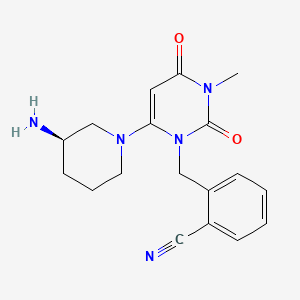
阿格列汀
描述
阿罗格列汀是一种口服抗糖尿病药物,属于二肽基肽酶-4 (DPP-4) 抑制剂类。它主要用于治疗 2 型糖尿病患者的高血糖症。阿罗格列汀通过抑制 DPP-4 酶发挥作用,该酶通常会降解增血糖素激素,例如葡萄糖依赖性胰岛素促分泌多肽 (GIP) 和胰高血糖素样肽-1 (GLP-1)。通过抑制 DPP-4,阿罗格列汀提高了活性增血糖素激素的水平,从而以葡萄糖依赖的方式增强胰岛素分泌并降低胰高血糖素水平 .
作用机制
阿罗格列汀通过抑制 DPP-4 酶发挥作用,该酶负责降解增血糖素激素。通过抑制 DPP-4,阿罗格列汀提高了活性增血糖素激素的水平,例如 GLP-1 和 GIP。这些激素增强胰腺β细胞的胰岛素分泌,并减少胰腺α细胞的胰高血糖素分泌,从而改善血糖控制。 阿罗格列汀抑制 DPP-4 也会导致活性增血糖素水平延长,这有助于其治疗效果 .
科学研究应用
阿罗格列汀具有广泛的科学研究应用,包括:
化学: 用作研究 DPP-4 抑制剂及其化学性质的模型化合物。
生物学: 研究其对细胞信号通路和酶抑制的影响。
生化分析
Biochemical Properties
Alogliptin interacts with the enzyme dipeptidyl peptidase-4 (DPP-4). This enzyme normally degrades the incretins glucose-dependent insulinotropic polypeptide (GIP) and glucagon-like peptide 1 (GLP-1). Alogliptin inhibits DPP-4, thereby increasing the levels of these incretins .
Cellular Effects
Alogliptin has been shown to have effects on various types of cells and cellular processes. It influences cell function by increasing the levels of incretins, which in turn help the body produce more insulin and stop the body from releasing too much sugar into the blood . This helps keep blood sugar levels stable.
Molecular Mechanism
The molecular mechanism of action of Alogliptin involves the inhibition of the DPP-4 enzyme. This inhibition results in prolonged active incretin levels, which help the body produce more insulin and stop the body from releasing too much sugar into the blood .
Temporal Effects in Laboratory Settings
In laboratory settings, peak inhibition of DPP-4 occurs within 2-3 hours after a single-dose administration of Alogliptin to healthy subjects. The peak inhibition of DPP-4 exceeded 93% across doses of 12.5 mg to 800 mg. Inhibition of DPP-4 remained above 80% at 24 hours for doses greater than or equal to 25 mg .
Dosage Effects in Animal Models
While specific studies on the dosage effects of Alogliptin in animal models were not found, it is generally recommended that the dosage of Alogliptin be adjusted based on the patient’s kidney function .
Metabolic Pathways
Alogliptin is involved in the metabolic pathway related to the regulation of blood sugar levels. It interacts with the DPP-4 enzyme and incretins such as GIP and GLP-1 .
Transport and Distribution
Alogliptin is well distributed into tissues. Following a single, 12.5 mg intravenous infusion of Alogliptin to healthy subjects, the volume of distribution during the terminal phase was 417 L .
Subcellular Localization
As a small molecule drug, Alogliptin is likely to be distributed throughout the cell, where it can interact with its target, the DPP-4 enzyme .
准备方法
合成路线和反应条件
阿罗格列汀是通过多步合成过程合成的,涉及关键中间体的形成。合成路线通常从制备 2-({6-[(3R)-3-氨基哌啶-1-基]-3-甲基-2,4-二氧代-3,4-二氢嘧啶-1(2H)-基}甲基)苯腈开始。 然后,该中间体经受各种化学反应,包括胺化和环化,以产生最终产物 .
工业生产方法
在工业环境中,阿罗格列汀的生产涉及使用高效液相色谱 (HPLC) 进行纯化和质量控制。该过程经过优化,以确保最终产物的产率高且纯度高。 在阿罗格列汀的工业生产中,通常使用先进的分析技术,如反相高效液相色谱 (RP-HPLC) .
化学反应分析
反应类型
阿罗格列汀会经历各种化学反应,包括:
氧化: 阿罗格列汀在特定条件下可以被氧化形成相应的氧化物。
还原: 还原反应可用于修饰阿罗格列汀中的官能团。
常用试剂和条件
阿罗格列汀化学反应中常用的试剂包括:
氧化剂: 例如过氧化氢和高锰酸钾。
还原剂: 例如硼氢化钠和氢化铝锂。
取代试剂: 例如卤素和烷基化试剂
主要形成的产物
阿罗格列汀化学反应形成的主要产物取决于所用反应条件和试剂。 例如,氧化可能会产生氧化物,而取代反应可能会产生卤代或烷基化衍生物 .
相似化合物的比较
阿罗格列汀是 DPP-4 抑制剂类的一部分,其中包括其他类似化合物,例如:
- 西格列汀
- 沙格列汀
- 利格列汀
- 维格列汀
阿罗格列汀的独特性
阿罗格列汀在 DPP-4 抑制剂中是独一无二的,因为它具有高度选择性和口服生物利用度。它具有相对较长的半衰期,允许每天一次给药。 此外,阿罗格列汀已被证明具有良好的安全性,低血糖风险低,对体重的影响最小 .
属性
IUPAC Name |
2-[[6-[(3R)-3-aminopiperidin-1-yl]-3-methyl-2,4-dioxopyrimidin-1-yl]methyl]benzonitrile | |
|---|---|---|
| Source | PubChem | |
| URL | https://pubchem.ncbi.nlm.nih.gov | |
| Description | Data deposited in or computed by PubChem | |
InChI |
InChI=1S/C18H21N5O2/c1-21-17(24)9-16(22-8-4-7-15(20)12-22)23(18(21)25)11-14-6-3-2-5-13(14)10-19/h2-3,5-6,9,15H,4,7-8,11-12,20H2,1H3/t15-/m1/s1 | |
| Source | PubChem | |
| URL | https://pubchem.ncbi.nlm.nih.gov | |
| Description | Data deposited in or computed by PubChem | |
InChI Key |
ZSBOMTDTBDDKMP-OAHLLOKOSA-N | |
| Source | PubChem | |
| URL | https://pubchem.ncbi.nlm.nih.gov | |
| Description | Data deposited in or computed by PubChem | |
Canonical SMILES |
CN1C(=O)C=C(N(C1=O)CC2=CC=CC=C2C#N)N3CCCC(C3)N | |
| Source | PubChem | |
| URL | https://pubchem.ncbi.nlm.nih.gov | |
| Description | Data deposited in or computed by PubChem | |
Isomeric SMILES |
CN1C(=O)C=C(N(C1=O)CC2=CC=CC=C2C#N)N3CCC[C@H](C3)N | |
| Source | PubChem | |
| URL | https://pubchem.ncbi.nlm.nih.gov | |
| Description | Data deposited in or computed by PubChem | |
Molecular Formula |
C18H21N5O2 | |
| Source | PubChem | |
| URL | https://pubchem.ncbi.nlm.nih.gov | |
| Description | Data deposited in or computed by PubChem | |
DSSTOX Substance ID |
DTXSID90234130 | |
| Record name | Alogliptin | |
| Source | EPA DSSTox | |
| URL | https://comptox.epa.gov/dashboard/DTXSID90234130 | |
| Description | DSSTox provides a high quality public chemistry resource for supporting improved predictive toxicology. | |
Molecular Weight |
339.4 g/mol | |
| Source | PubChem | |
| URL | https://pubchem.ncbi.nlm.nih.gov | |
| Description | Data deposited in or computed by PubChem | |
Solubility |
Sparingly soluble | |
| Record name | Alogliptin | |
| Source | DrugBank | |
| URL | https://www.drugbank.ca/drugs/DB06203 | |
| Description | The DrugBank database is a unique bioinformatics and cheminformatics resource that combines detailed drug (i.e. chemical, pharmacological and pharmaceutical) data with comprehensive drug target (i.e. sequence, structure, and pathway) information. | |
| Explanation | Creative Common's Attribution-NonCommercial 4.0 International License (http://creativecommons.org/licenses/by-nc/4.0/legalcode) | |
Mechanism of Action |
Alogliptin inhibits dipeptidyl peptidase 4 (DPP-4), which normally degrades the incretins glucose-dependent insulinotropic polypeptide (GIP) and glucagon like peptide 1 ( GLP-1). The inhibition of DPP-4 increases the amount of active plasma incretins which helps with glycemic control. GIP and GLP-1 stimulate glucose dependent secretion of insulin in pancreatic beta cells. GLP-1 has the additional effects of suppressing glucose dependent glucagon secretion, inducing satiety, reducing food intake, and reducing gastric emptying., Increased concentrations of the incretin hormones such as glucagon-like peptide-1 (GLP-1) and glucose-dependent insulinotropic polypeptide (GIP) are released into the bloodstream from the small intestine in response to meals. These hormones cause insulin release from the pancreatic beta cells in a glucose-dependent manner but are inactivated by the DPP-4 enzyme within minutes. GLP-1 also lowers glucagon secretion from pancreatic alpha cells, reducing hepatic glucose production. In patients with type 2 diabetes, concentrations of GLP-1 are reduced but the insulin response to GLP-1 is preserved. Alogliptin is a DPP-4 inhibitor that slows the inactivation of the incretin hormones, thereby increasing their bloodstream concentrations and reducing fasting and postprandial glucose concentrations in a glucose-dependent manner in patients with type 2 diabetes mellitus. Alogliptin selectively binds to and inhibits DPP-4 but not DPP-8 or DPP-9 activity in vitro at concentrations approximating therapeutic exposures. | |
| Record name | Alogliptin | |
| Source | DrugBank | |
| URL | https://www.drugbank.ca/drugs/DB06203 | |
| Description | The DrugBank database is a unique bioinformatics and cheminformatics resource that combines detailed drug (i.e. chemical, pharmacological and pharmaceutical) data with comprehensive drug target (i.e. sequence, structure, and pathway) information. | |
| Explanation | Creative Common's Attribution-NonCommercial 4.0 International License (http://creativecommons.org/licenses/by-nc/4.0/legalcode) | |
| Record name | Alogliptin | |
| Source | Hazardous Substances Data Bank (HSDB) | |
| URL | https://pubchem.ncbi.nlm.nih.gov/source/hsdb/8203 | |
| Description | The Hazardous Substances Data Bank (HSDB) is a toxicology database that focuses on the toxicology of potentially hazardous chemicals. It provides information on human exposure, industrial hygiene, emergency handling procedures, environmental fate, regulatory requirements, nanomaterials, and related areas. The information in HSDB has been assessed by a Scientific Review Panel. | |
CAS No. |
850649-61-5 | |
| Record name | Alogliptin | |
| Source | CAS Common Chemistry | |
| URL | https://commonchemistry.cas.org/detail?cas_rn=850649-61-5 | |
| Description | CAS Common Chemistry is an open community resource for accessing chemical information. Nearly 500,000 chemical substances from CAS REGISTRY cover areas of community interest, including common and frequently regulated chemicals, and those relevant to high school and undergraduate chemistry classes. This chemical information, curated by our expert scientists, is provided in alignment with our mission as a division of the American Chemical Society. | |
| Explanation | The data from CAS Common Chemistry is provided under a CC-BY-NC 4.0 license, unless otherwise stated. | |
| Record name | Alogliptin [INN] | |
| Source | ChemIDplus | |
| URL | https://pubchem.ncbi.nlm.nih.gov/substance/?source=chemidplus&sourceid=0850649615 | |
| Description | ChemIDplus is a free, web search system that provides access to the structure and nomenclature authority files used for the identification of chemical substances cited in National Library of Medicine (NLM) databases, including the TOXNET system. | |
| Record name | Alogliptin | |
| Source | DrugBank | |
| URL | https://www.drugbank.ca/drugs/DB06203 | |
| Description | The DrugBank database is a unique bioinformatics and cheminformatics resource that combines detailed drug (i.e. chemical, pharmacological and pharmaceutical) data with comprehensive drug target (i.e. sequence, structure, and pathway) information. | |
| Explanation | Creative Common's Attribution-NonCommercial 4.0 International License (http://creativecommons.org/licenses/by-nc/4.0/legalcode) | |
| Record name | Alogliptin | |
| Source | EPA DSSTox | |
| URL | https://comptox.epa.gov/dashboard/DTXSID90234130 | |
| Description | DSSTox provides a high quality public chemistry resource for supporting improved predictive toxicology. | |
| Record name | 2-[[6-[(3R)-3-aminopiperidin-1-yl]-3-methyl-2,4-dioxopyrimidin-1-yl]methyl]benzonitrile | |
| Source | European Chemicals Agency (ECHA) | |
| URL | https://echa.europa.eu/information-on-chemicals | |
| Description | The European Chemicals Agency (ECHA) is an agency of the European Union which is the driving force among regulatory authorities in implementing the EU's groundbreaking chemicals legislation for the benefit of human health and the environment as well as for innovation and competitiveness. | |
| Explanation | Use of the information, documents and data from the ECHA website is subject to the terms and conditions of this Legal Notice, and subject to other binding limitations provided for under applicable law, the information, documents and data made available on the ECHA website may be reproduced, distributed and/or used, totally or in part, for non-commercial purposes provided that ECHA is acknowledged as the source: "Source: European Chemicals Agency, http://echa.europa.eu/". Such acknowledgement must be included in each copy of the material. ECHA permits and encourages organisations and individuals to create links to the ECHA website under the following cumulative conditions: Links can only be made to webpages that provide a link to the Legal Notice page. | |
| Record name | ALOGLIPTIN | |
| Source | FDA Global Substance Registration System (GSRS) | |
| URL | https://gsrs.ncats.nih.gov/ginas/app/beta/substances/JHC049LO86 | |
| Description | The FDA Global Substance Registration System (GSRS) enables the efficient and accurate exchange of information on what substances are in regulated products. Instead of relying on names, which vary across regulatory domains, countries, and regions, the GSRS knowledge base makes it possible for substances to be defined by standardized, scientific descriptions. | |
| Explanation | Unless otherwise noted, the contents of the FDA website (www.fda.gov), both text and graphics, are not copyrighted. They are in the public domain and may be republished, reprinted and otherwise used freely by anyone without the need to obtain permission from FDA. Credit to the U.S. Food and Drug Administration as the source is appreciated but not required. | |
| Record name | Alogliptin | |
| Source | Hazardous Substances Data Bank (HSDB) | |
| URL | https://pubchem.ncbi.nlm.nih.gov/source/hsdb/8203 | |
| Description | The Hazardous Substances Data Bank (HSDB) is a toxicology database that focuses on the toxicology of potentially hazardous chemicals. It provides information on human exposure, industrial hygiene, emergency handling procedures, environmental fate, regulatory requirements, nanomaterials, and related areas. The information in HSDB has been assessed by a Scientific Review Panel. | |
Retrosynthesis Analysis
AI-Powered Synthesis Planning: Our tool employs the Template_relevance Pistachio, Template_relevance Bkms_metabolic, Template_relevance Pistachio_ringbreaker, Template_relevance Reaxys, Template_relevance Reaxys_biocatalysis model, leveraging a vast database of chemical reactions to predict feasible synthetic routes.
One-Step Synthesis Focus: Specifically designed for one-step synthesis, it provides concise and direct routes for your target compounds, streamlining the synthesis process.
Accurate Predictions: Utilizing the extensive PISTACHIO, BKMS_METABOLIC, PISTACHIO_RINGBREAKER, REAXYS, REAXYS_BIOCATALYSIS database, our tool offers high-accuracy predictions, reflecting the latest in chemical research and data.
Strategy Settings
| Precursor scoring | Relevance Heuristic |
|---|---|
| Min. plausibility | 0.01 |
| Model | Template_relevance |
| Template Set | Pistachio/Bkms_metabolic/Pistachio_ringbreaker/Reaxys/Reaxys_biocatalysis |
| Top-N result to add to graph | 6 |
Feasible Synthetic Routes
A: [, , , , , , , , ] Alogliptin functions as a highly selective dipeptidyl peptidase-4 (DPP-4) inhibitor. DPP-4 is an enzyme that rapidly inactivates incretin hormones, primarily glucagon-like peptide-1 (GLP-1) and glucose-dependent insulinotropic polypeptide (GIP). By inhibiting DPP-4, alogliptin increases the levels of GLP-1 and GIP, which in turn leads to enhanced insulin secretion from pancreatic beta cells and suppressed glucagon secretion, ultimately resulting in improved glucose homeostasis.
A: The molecular formula of alogliptin benzoate (the active form) is C18H18N6O3 • C7H6O2, and its molecular weight is 462.46 g/mol.
A: While the provided papers don’t delve into detailed formulation strategies for alogliptin, one study explored the use of injectable long-acting poly (lactide-co-glycolide) (PLGA)-based in situ gel implants (ISGI) loaded with alogliptin . This approach aimed to provide sustained therapeutic exposures and improve pharmacological responses, potentially leading to reduced dosing frequency and enhanced patient compliance. The study highlighted the effectiveness of solvents like N-methyl-2-pyrrolidone (NMP) and dimethyl sulfoxide (DMSO) in achieving successful ISGI preparation and controlling the release profile of alogliptin.
A: [, , ] Alogliptin demonstrates moderate absorption, exceeding 75%, and its absorption is not significantly affected by food [, ]. It exhibits slow-binding properties to the DPP-4 enzyme, resulting in sustained reduction of plasma DPP-4 activity . Alogliptin has low plasma protein binding . Although the provided papers don't extensively detail its metabolism, they indicate that alogliptin is primarily excreted renally .
A: Research indicates that creatinine clearance and weight can significantly influence the oral clearance (CL/F) of alogliptin . This suggests that dose adjustments may be necessary for patients with renal impairment, while weight-based adjustments are generally not clinically relevant.
A: [, ] Studies haven't identified any significant drug interactions with alogliptin monotherapy [, ]. Notably, it can be co-administered with medications like ketoconazole, fluconazole, gemfibrozil, warfarin, metformin, glyburide, and pioglitazone without requiring dosage adjustments .
A: A study using diabetic apolipoprotein E-deficient mice showed that alogliptin treatment effectively reduced atherosclerotic lesions . This protective effect was linked to alogliptin's ability to lower plasma glucose levels and attenuate the expression of inflammatory cytokines (IL-6 and IL-1β) within the atherosclerotic plaques.
A: Research in rabbits suggests that alogliptin exhibits cardioprotective effects against ischemia-reperfusion injury . The study attributed these benefits to alogliptin's ability to enhance nitric oxide production through both GLP-1 receptor-dependent and -independent pathways. This increased nitric oxide production was associated with improved left ventricular ejection fraction and ±dP/dt, indicating enhanced cardiac function.
A: [, , , , , , , , , , ] Numerous clinical trials have demonstrated the efficacy of alogliptin in improving glycemic control in patients with type 2 diabetes. Alogliptin, as monotherapy or in combination with other antidiabetic agents, consistently led to significant reductions in HbA1c levels [, , , , , , , , , , ]. Studies also highlight its efficacy in specific patient populations, such as those with inadequate glycemic control on metformin [, , ] or those receiving insulin therapy .
A: While traditional oral formulations of alogliptin are available, researchers are investigating injectable long-acting PLGA-based ISGI as a potential alternative delivery system. This approach aims to enhance patient compliance and potentially improve the therapeutic outcomes by achieving sustained drug release.
A: Research suggests that urinary angiotensinogen (AGT) levels could potentially serve as a prognostic marker for the renoprotective effects of alogliptin in patients with type 2 diabetes . The study observed a correlation between higher baseline urinary AGT levels and a more pronounced decrease in urinary albumin-to-creatinine ratio (UACR) following alogliptin treatment. This finding implies that urinary AGT could potentially help identify patients who are more likely to benefit from the renoprotective effects of alogliptin.
A: [, , ] Several analytical methods have been developed and validated for the quantification of alogliptin, including:
- UV Spectrophotometry: This technique utilizes the absorbance of UV-visible light by alogliptin at specific wavelengths for its quantification. It's a simple and cost-effective method often used for routine analysis of alogliptin in pharmaceutical formulations. [, ]
- High-Performance Thin-Layer Chromatography (HPTLC): HPTLC is a versatile technique that separates and quantifies alogliptin based on its differential migration on a thin layer of adsorbent material.
- Reverse-Phase High-Performance Liquid Chromatography (RP-HPLC): RP-HPLC offers high sensitivity and selectivity in separating and quantifying alogliptin in complex matrices like pharmaceutical formulations and biological samples. It's often coupled with UV detection for quantification. [, ]
- Liquid Chromatography-Tandem Mass Spectrometry (LC-MS/MS): LC-MS/MS provides exceptional sensitivity and specificity for quantifying alogliptin in biological matrices, particularly at low concentrations. It's often the preferred method for pharmacokinetic studies.
A: [, , ] The development and validation of analytical methods for alogliptin quantification involve assessing key validation parameters as outlined by regulatory guidelines, such as the International Conference on Harmonisation (ICH) guidelines. These parameters include:
A: [, , , , ] Several alternatives to alogliptin are available for managing type 2 diabetes, including:
- Other DPP-4 Inhibitors: As mentioned earlier, other DPP-4 inhibitors like sitagliptin, vildagliptin, saxagliptin, and linagliptin offer similar mechanisms of action and comparable efficacy to alogliptin in terms of HbA1c reduction. [, , , , ]
- Metformin: Metformin is a first-line treatment for type 2 diabetes that improves insulin sensitivity and reduces hepatic glucose production. It is often used in combination with DPP-4 inhibitors or GLP-1 receptor agonists. [, ]
A: [, ] Alogliptin received approval from the US Food and Drug Administration (FDA) for the treatment of type 2 diabetes in 2013. [, ]
体外研究产品的免责声明和信息
请注意,BenchChem 上展示的所有文章和产品信息仅供信息参考。 BenchChem 上可购买的产品专为体外研究设计,这些研究在生物体外进行。体外研究,源自拉丁语 "in glass",涉及在受控实验室环境中使用细胞或组织进行的实验。重要的是要注意,这些产品没有被归类为药物或药品,他们没有得到 FDA 的批准,用于预防、治疗或治愈任何医疗状况、疾病或疾病。我们必须强调,将这些产品以任何形式引入人类或动物的身体都是法律严格禁止的。遵守这些指南对确保研究和实验的法律和道德标准的符合性至关重要。


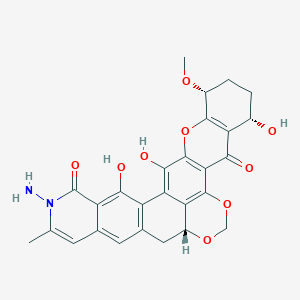
![[5-(3,6-diaminohexanoylamino)-3-hydroxy-2-(hydroxymethyl)-6-[(5-methyl-4-oxo-3a,6,7,7a-tetrahydro-1H-imidazo[4,5-c]pyridin-2-yl)amino]oxan-4-yl] carbamate](/img/structure/B1666815.png)
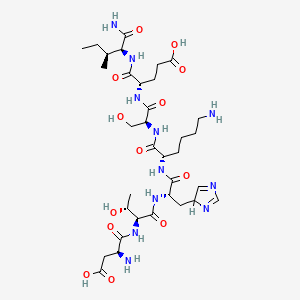
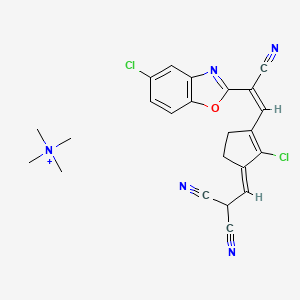

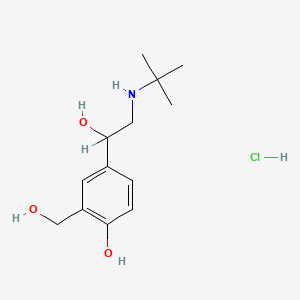


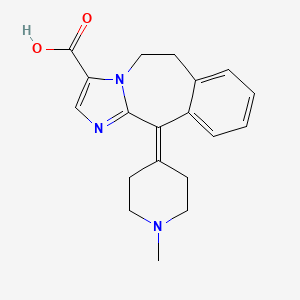
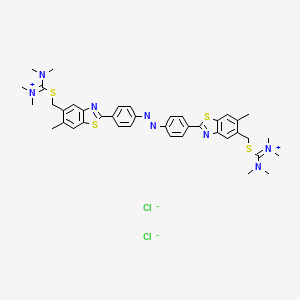

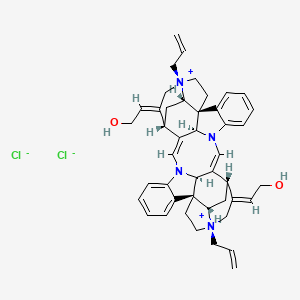
![3-[2-[(E)-4-hydroxy-3,5-dimethyl-2-[3,4,5-trihydroxy-6-(hydroxymethyl)oxan-2-yl]oxyoct-5-enyl]-1,3,6,8-tetramethyl-4a,5,6,7,8,8a-hexahydro-2H-naphthalen-1-yl]-3-oxopropanal](/img/structure/B1666832.png)

